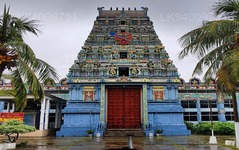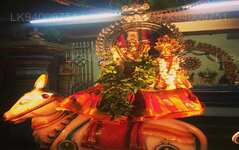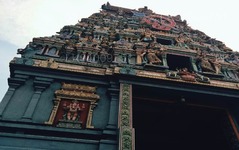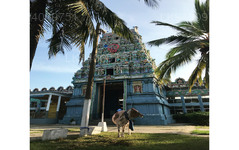
Miasto Kolombo
Kolombo, stolica Sri Lanki, to dynamiczne miasto łączące tradycję z nowoczesnością. Zachwyca kolonialną architekturą, tętniącymi życiem targowiskami i spokojnymi świątyniami buddyjskimi. Z różnorodną kuchnią, rozległą panoramą i pięknymi plażami, stanowi tętniące życiem centrum biznesu, kultury i turystyki, oferując bramę do odkrywania cudów Sri Lanki.
Old Kathiresan Temple
Old Kathiresan Temple is a massive century old Hindu cultural site hidden amongst the busy business centre of Colombo City. It is located in Colombo 4 (Bambalapitiya) a little further on from the twin Hindu Temples opposite the Bambalapitiya Apartment Complex, and is adjoining Vajira Road.
Kathiresan (Light Rayed Lord) is another name for Lord Murugan, the Hindu God of Light, Love and War. Wen the temple was initially built, Lord Murugan was considered the main deity of the temple and enshrined in the central shrine. As such it gained the name Kathiresan Temple. With the building of another Murugan Temple nearby (the one directly opposite the apartments mentioned before), which was named New Kathiresan Temple,, this one began to be called Old Kathiresan temple to differentiate it. In addition, with time the temple,s Ganesha shrine became highly popular and earned the place the name Vajira Road Pillaiyar (Ganesha) Kovil, or ‘Vijira Pilaiyar Kovil,..
While the Old Kathiresan Temple is quite old and has a long history, it remains a quiet place of peace and solace. One of the reasons for this is that it is still not as popular as the nearby temples, as the temple only opened back up recently after a very long stint of renovations. For the youth of Colombo, this temple is pretty much unknown place as it has remained under construction for over a decade.
However, now that it has opened its doors to devotees once again, the work done on the temple has been found to be amazing. A beautiful green lawn and a tall colorful temple tower welcome The new coats of paint add a touch of color to the temple,s original structure. Many new additions have been made with an impeccable eye to detail. The deities in the shrines are beautifully carved and in some shrines, where they were initially too small or crudely made, replaced with black granite statues from India done by master stone carvers.
Visiting the Temple
When visiting Hindu temples it is a custom to cleanse yourself properly and wear clean washed clothes when visiting, as they are holy places. You can also take offerings such as flowers, incense sticks, garlands, silk or satin cloth for draping the deities, etc. There are usually garland sellers near the entrance of the temple who sell many types of offerings.
Before entering the temple remove your footwear and hand it over to the person who handles this near the entrance. Wash your feet at the tap close to where your footwear is kept, to cleanse them. Also wash your offerings if they are washable (garlands or flowers), or sprinkle some fresh clean water if not.
Once you enter you will be faced with the main shrine. After giving your offerings you can buy a ticket for a pooja. They will ask for your name and astrological birth star. If you don’t know your star, you can just give your name. Then there will be a pooja and some blessed pooja objects (a banana on a betel leaf, holy ash, flowers from the pooja, etc) will be given to you to take home.
You can then move clockwise around the rest of the temple looking at the other shrines, such as the Ganesha and Shiva shrines. You can also request to do poojas at the other shrines with purchased tickets from the counter inside if you wish. Towards the back you will come to a shrine with some recent Indian saints: Sai Baba and Shirti Sai Baba. If you are a believer in these saints, you may enjoy a visit here.
There are also some cows and roosters at the temple. The cows are used to provide milk for the poojas, while the roosters are kept because they have special significance to the main deity of the temple Murugan. According to legend, Lord Murugan battled an evil demon to save the people of heaven and earth. During the battle the demon attempted to escape by hiding in the form of a mango tree. But it was discovered, and Murugan split the demon into two with his spear. One of the split parts turned into a peacock, and the other a rooster. The peacock became Murugan,s vehicle for travel, while the colorful rooster became his flag. Hence, this Murugan temple – like many others – has roosters walking around with great aplomb.
There is much to see and enjoy at this temple. It makes for a pleasant space of worship and solace in a city of bustling tradespeople and workers.
O dystrykcie Kolombo
Kolombo to największe miasto i stolica handlowa Sri Lanki. Położone jest na zachodnim wybrzeżu wyspy, w sąsiedztwie Sri Jayewardenepura Kotte, stolicy Sri Lanki. Kolombo to tętniące życiem i pełne życia miasto, łączące w sobie nowoczesny styl życia z kolonialnymi budynkami i ruinami. Liczba mieszkańców wynosi 647 100. Region Metropolitalny Kolombo, definiowany przez dystrykty Kolombo, Gampaha i Kalutara, liczy około 5 648 000 mieszkańców i zajmuje powierzchnię 3694,20 km². Kolombo to miasto wieloetniczne i wielokulturowe. Jest to najludniejsze miasto na Sri Lance, z 642 163 mieszkańcami mieszkającymi w granicach miasta. Populacja Kolombo to mieszanka licznych grup etnicznych, głównie Syngalezów, Maurów i Tamilów. W mieście mieszkają również niewielkie społeczności osób pochodzenia chińskiego, portugalskiego, holenderskiego, malajskiego i indyjskiego, a także liczni europejscy emigranci. Zdecydowana większość lankijskich korporacji ma swoje siedziby w Kolombo. Wśród branż znajdują się m.in. przemysł chemiczny, tekstylny, szklarski, cementowy, skórzany, meblarski i jubilerski. W centrum miasta znajduje się drugi co do wysokości budynek w Azji Południowej – World Trade Center.
O dystrykcie Kolombo
Prowincja Zachodnia jest najgęściej zaludnioną prowincją Sri Lanki. Znajduje się tu stolica parlamentarna Sri Dźajawardanapura Kotte, a także Kolombo, centrum administracyjne i biznesowe kraju. Prowincja Zachodnia dzieli się na trzy główne dystrykty: Kolombo (642 km²), Gampaha (1386,6 km²) i Kalutara (1606 km²). Jako centrum gospodarcze Sri Lanki, w mieście obecne są wszystkie główne lokalne i międzynarodowe korporacje, a także wszyscy najwięksi projektanci i detaliści, dlatego warto przygotować się na zakupy w prowincji Zachodniej. Z uwagi na największą liczbę ludności w całej prowincji, w prowincji Zachodniej znajdują się niemal wszystkie najważniejsze instytucje edukacyjne na wyspie. Do uniwersytetów w prowincji zaliczają się: Uniwersytet Kolombo, Uniwersytet Sri Jayewardenepura, Uniwersytet Kelaniya, Otwarty Uniwersytet Sri Lanki, Uniwersytet Buddyjski i Palijski Sri Lanki, Uniwersytet Obrony Generała Sir Johna Kotelawali i Uniwersytet Moratuwa. W prowincji zachodniej znajduje się najwięcej szkół w kraju, w tym szkoły państwowe, prowincjonalne, prywatne i międzynarodowe.










































